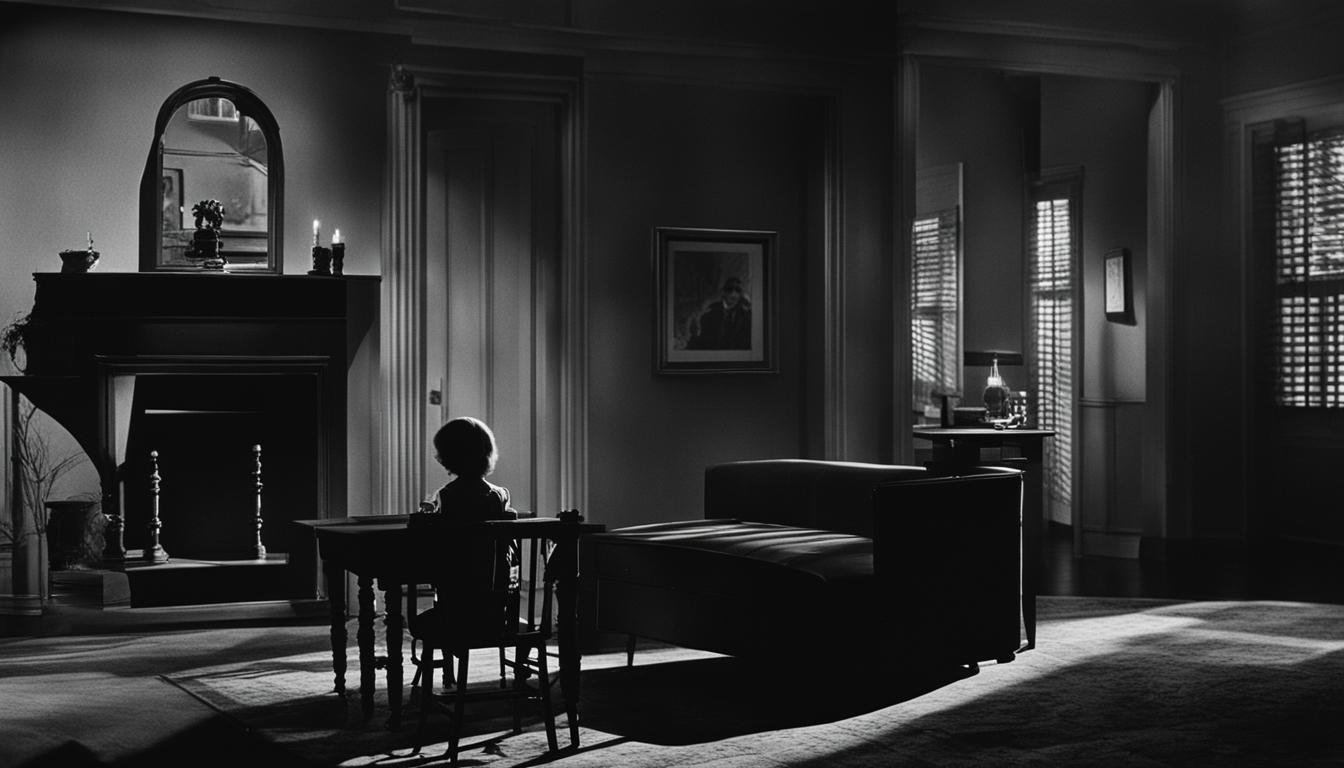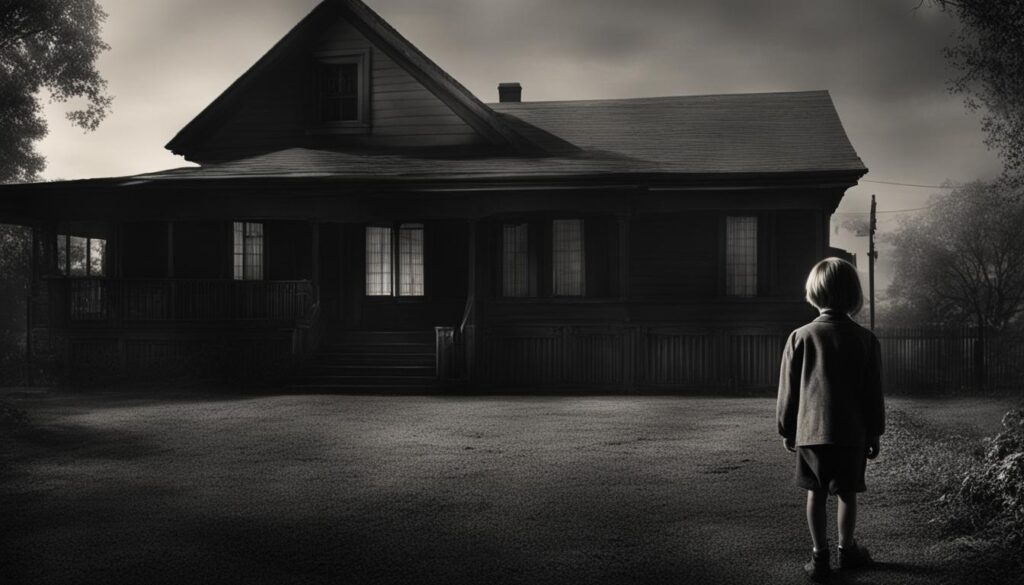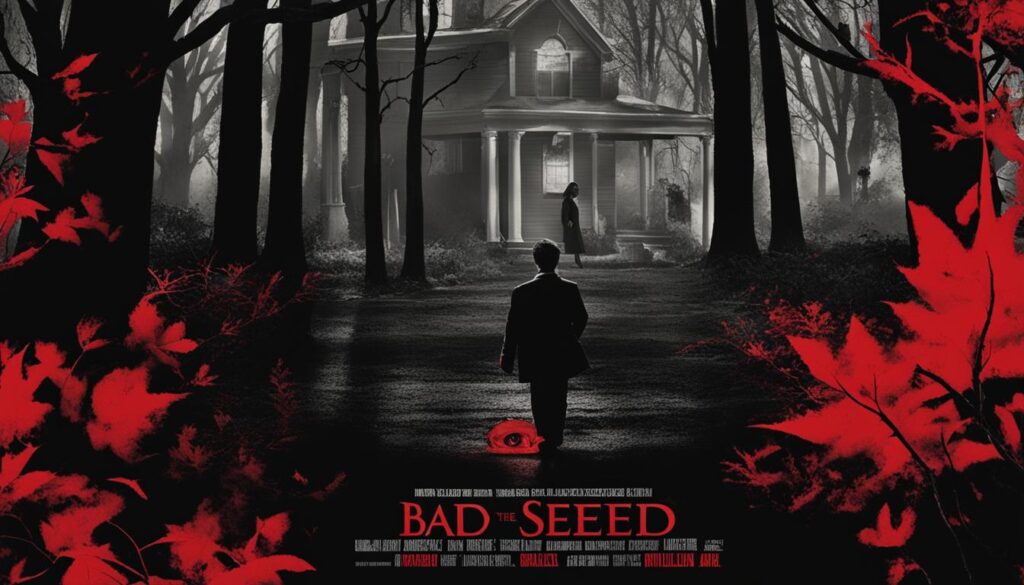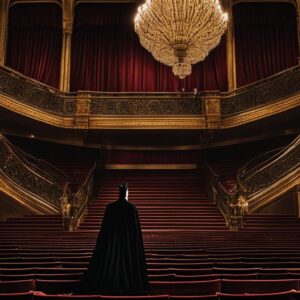Welcome to my article on The Bad Seed (1956), a psychological thriller that has become a classic in the genre of horror movies. This film delves into the dark secrets hidden within the innocence of children, specifically focusing on the character of Rhoda Penmark, a child sociopath. It explores the nature versus nurture debate and showcases iconic performances that have left a lasting impact on classic cinema.
Key Takeaways:
- The Bad Seed (1956) is a pioneering psychological thriller in the genre of classic films.
- The film explores the concept of evil in children, delving into dark secrets and the nature versus nurture debate.
- Iconic performances, particularly Patricia McCormack’s portrayal of Rhoda Penmark, have solidified the film’s status in classic cinema.
- The Bad Seed continues to captivate audiences with its chilling storyline and exploration of thought-provoking themes.
- It remains a must-watch for fans of psychological thrillers and classic cinema.
The Cast and Characters of The Bad Seed (1956)
In The Bad Seed (1956), Patricia McCormack portrays the central character of Rhoda Penmark, a child with a dark secret. Nancy Kelly plays Christine Penmark, Rhoda’s mother who slowly uncovers her daughter’s true nature. Eileen Heckart and Henry Jones also deliver memorable performances as supporting characters. The cast of The Bad Seed brings the story to life with their exceptional acting skills, creating a chilling atmosphere throughout the film.
| Character | Actor/Actress |
|---|---|
| Rhoda Penmark | Patricia McCormack |
| Christine Penmark | Nancy Kelly |
| Monica Breedlove | Eileen Heckart |
| LeRoy Jessup | Henry Jones |
The performances by Patricia McCormack as Rhoda Penmark and Nancy Kelly as Christine Penmark are particularly noteworthy. McCormack’s portrayal of the manipulative and dangerous Rhoda is both captivating and chilling, leaving a lasting impact on audiences. Similarly, Kelly’s portrayal of Christine as a mother slowly unraveling the dark secrets of her own child is filled with tension.
The talented ensemble cast of The Bad Seed brings depth and complexity to each character, enhancing the overall suspense and intrigue of the film. Their exceptional performances contribute to the enduring popularity and legacy of this classic psychological thriller.
The Storyline of The Bad Seed (1956)
The Bad Seed (1956) follows the chilling storyline of Rhoda Penmark, a seemingly innocent young girl living in a small town. As the film unfolds, it becomes clear that Rhoda is harboring dark secrets and exhibiting sociopathic tendencies. Her facade of innocence quickly crumbles as she shows a willingness to commit murder to protect her secrets. The plot centers around the investigation into Rhoda’s actions, as her mother and other characters in the film slowly begin to uncover the truth about her sinister nature.
The film delves deep into the exploration of a child sociopath, highlighting the terrifying reality that evil can exist even in the young and innocent. The residents of the small town find themselves caught up in a web of murder and deceit, as they grapple with the shocking revelations about Rhoda.
The Bad Seed (1956) is a psychological thriller that keeps viewers on the edge of their seats, as they are taken on a suspenseful journey through the dark underbelly of human nature. It masterfully portrays the tension between appearance and reality, as Rhoda’s true nature is gradually unveiled. Set in a small town, the film creates a sense of claustrophobia and paranoia, intensifying the psychological impact of the story. The storyline of The Bad Seed is a captivating exploration of the consequences of hidden dark secrets and the investigation that unravels them.
The Dark Secrets Unveiled
In The Bad Seed (1956), the investigation into Rhoda’s actions serves as the driving force behind the plot. As her mother and others dig deeper, they uncover a web of dark secrets that reveal the true extent of Rhoda’s malevolence. The film explores the psychological tension that arises as the investigation unfolds, keeping viewers on the edge of their seats as they anticipate the next shocking revelation.
The small town setting adds another layer of intrigue to the storyline, as the close-knit community grapples with the realization that evil can lurk even in the most innocent-looking individuals. The film poses thought-provoking questions about the nature of evil and the role of nurture in shaping a person’s character, leaving audiences with a lasting impression and fueling discussions about the complexities of human behavior.
| Key Themes | Details |
|---|---|
| Child Sociopathy | The film delves into the disturbing concept of a child sociopath, challenging societal notions of innocence and exploring the origins of evil in children. |
| Murder and Dark Secrets | The storyline revolves around Rhoda’s willingness to commit murder to protect her secrets, leading to a web of dark secrets that are slowly uncovered. |
| Investigation and Small Town Paranoia | The investigation into Rhoda’s actions drives the plot, creating a sense of paranoia and tension within the small town setting. |
Influence on Thriller Films
The Bad Seed (1956) had a significant influence on the thriller genre, particularly in the portrayal of evil children and the exploration of suspenseful themes. This psychological thriller paved the way for subsequent films that delved into similar concepts, sparking a trend in the industry. The portrayal of child sociopaths and the examination of the nature versus nurture debate became recurring themes in suspenseful movies.
The Bad Seed is often cited as one of the earliest examples of this concept, setting the stage for future films to build upon. Its impact can still be seen in contemporary thrillers that explore the dark side of innocent-looking characters. The film’s ability to captivate audiences with its suspenseful plot and memorable performances has solidified its status as an influential classic.
“The Bad Seed (1956) set a new standard for psychological thrillers, creating a benchmark for films to come.” – Film Critic
Through its exploration of the sinister side of childhood, The Bad Seed pushed the boundaries of what was considered acceptable in cinema at the time. It challenged societal perceptions, forcing audiences to confront the idea that evil can exist in the most unexpected of places. This provocative exploration of the human psyche continues to resonate with viewers today, making The Bad Seed a timeless and influential film.
| Film | Year |
|---|---|
| The Omen | 1976 |
| The Sixth Sense | 1999 |
| We Need to Talk About Kevin | 2011 |
| Orphan | 2009 |
The Legacy of The Bad Seed (1956)
The Bad Seed (1956) has left an indelible mark on the world of cinema, cementing its status as an iconic film in the psychological thriller genre. Its enduring popularity is a testament to its timeless appeal and the impact it has had on audiences over the years. The film continues to captivate viewers with its suspenseful storyline, memorable performances, and exploration of dark themes.
Throughout the decades, The Bad Seed has maintained a cult following and is often referenced and celebrated as a classic in the realm of cinema. Its examination of the nature of evil in children and the concept of a child sociopath challenged societal perceptions and sparked thought-provoking conversations about human behavior and morality.
“The Bad Seed is a gripping and thought-provoking film that pushes the boundaries of the psychological thriller genre. It has become a cultural touchstone and continues to be studied and referenced in discussions about psychology and ethics.”
The film’s impact on the genre can still be seen today, as it paved the way for many subsequent films that explore similar themes and concepts. The Bad Seed’s legacy is evident in the continued fascination with the portrayal of evil children in cinema. Its enduring popularity speaks to its status as a timeless classic, beloved by fans of classic cinema and new generations of viewers alike.
| Legacy of The Bad Seed (1956) | Cultural Impact | Influence on Genre |
|---|---|---|
| Enduring popularity | Exploration of the nature of evil | Portrayal of evil children |
| Iconic status | Challenging societal perceptions | Inspiration for subsequent films |
| Beloved by fans | Sparking conversations about morality | Cultural touchstone |
Patricia McCormack’s Career Before and After The Bad Seed (1956)
Before her breakout role in The Bad Seed (1956), Patricia McCormack had already established herself as a successful child performer. She gained recognition for her exceptional talent and captivating performances, paving the way for her future success in the entertainment industry. However, it was her role as Rhoda Penmark in The Bad Seed that truly propelled her career to new heights.
The Bad Seed marked a turning point in McCormack’s career, showcasing her versatility as an actress and earning her widespread acclaim. Her portrayal of the manipulative and dangerous Rhoda Penmark was nothing short of iconic, leaving a lasting impact on audiences and critics alike. McCormack’s ability to embody such a complex and chilling character showcased her immense talent and set her apart as a force to be reckoned with in the industry.
Following her success in The Bad Seed, McCormack continued to work in both film and television, transitioning to more adult roles. Throughout her long and accomplished career, she demonstrated her range and versatility as an actress, taking on a wide variety of characters. From dramatic roles to comedic performances, McCormack proved time and time again that she was a talented and versatile performer.
Table: Patricia McCormack’s Filmography
| Year | Film/TV Show | Role |
|---|---|---|
| 1950 | Two Gals and a Guy | Norma |
| 1952 | She’s Back on Broadway | Patricia Willis |
| 1952 | Clash by Night | Girl at Party |
| 1954 | Young at Heart | Janey Blane |
| 1955 | Sheldon Leonard’s Playhouse | Joan |
| 1956 | The Bad Seed | Rhoda Penmark |
| … | … | … |
The Critical Reception of The Bad Seed (1956)
The Bad Seed (1956) received positive critical reception upon its release, with critics praising its compelling storyline and Patricia McCormack’s iconic performance as Rhoda Penmark. Critics and audiences alike were captivated by McCormack’s portrayal of the manipulative and dangerous child sociopath, which solidified her status as a talented actress. The film’s exploration of psychological thrills and dark themes in a suspenseful atmosphere contributed to its positive reception.
“Patricia McCormack delivers an unforgettable performance as Rhoda Penmark, showcasing her exceptional talent and bringing the character to life with chilling precision. Her portrayal of a seemingly innocent child with a sinister nature is haunting and iconic.” – Movie Critic
The Bad Seed (1956) is often regarded as a classic in the genre of psychological thrillers due to its critical acclaim and enduring impact on the industry. The film’s exploration of the dark secrets hidden within children and its examination of the nature versus nurture debate sparked discussions and debates among audiences. The Bad Seed’s critical success further solidified its place as a must-watch film for fans of the genre.
| Publication | Review |
|---|---|
| The New York Times | “A mesmerizing psychological thriller that keeps viewers on the edge of their seats. Patricia McCormack delivers an iconic performance that will leave you haunted.” |
| Variety | “The Bad Seed is a chilling masterpiece that delves deep into the darkest corners of human nature. McCormack’s performance is nothing short of extraordinary.” |
| Roger Ebert | “A gripping exploration of the evil that lurks within the innocence of children. Patricia McCormack’s performance is a tour de force that will leave you breathless.” |
The Cultural Impact of The Bad Seed (1956)
The Bad Seed (1956) has made a significant cultural impact since its release, sparking discussions and debates surrounding the exploration of evil within a child sociopath and the age-old question of nature versus nurture. The film challenges societal perceptions by portraying a seemingly innocent child capable of committing heinous acts, forcing audiences to confront the complexities of human behavior and morality.
With its thought-provoking themes, The Bad Seed (1956) broke new ground and prompted a reevaluation of the boundaries of psychological thrillers. It showcased the potential for children to possess darkness within them and the potential consequences of ignoring or nurturing these tendencies. The film’s impact is still felt to this day, as it continues to be studied and referenced in discussions about psychology, ethics, and the potential for evil in unexpected places.
The Bad Seed (1956) creates a lasting impression through its exploration of the human psyche, leaving viewers with a sense of unease and a lingering question: What is the true nature of evil, and how does it manifest within an innocent child? This enduring impact has solidified The Bad Seed as not only a classic film but also a powerful cultural touchstone that pushes boundaries and challenges our understanding of good and evil.
The Cinematic Style of The Bad Seed (1956)
The Bad Seed (1956) is renowned for its distinctive cinematic style, which contributes to the film’s suspenseful atmosphere and psychological tension. Shot in black and white, the use of this visual aesthetic creates a stark and shadowy world that heightens the eerie and chilling nature of the story. The contrast between light and dark adds depth to the narrative, accentuating the underlying themes of good versus evil and the duality of human nature.
The cinematography of The Bad Seed emphasizes the psychological tension through the skillful use of lighting and camera angles. Low-key lighting, with its strong contrast between light and shadow, creates a sense of mystery and unease. The interplay between light and dark mirrors the moral ambiguity at the heart of the film, highlighting the internal struggles faced by the characters.
Furthermore, the strategic use of camera angles enhances the suspenseful atmosphere of The Bad Seed. Dutch angles, low angles, and close-ups are employed to intensify the emotional impact and heighten the audience’s anticipation. The composition of each shot, carefully crafted by the filmmakers, places the viewer in the center of the psychological turmoil experienced by the characters, immersing them in the unsettling world of the film.
Table: Cinematic Style in The Bad Seed (1956)
| Visual Elements | Description |
|---|---|
| Black and White Aesthetic | Creates a stark and shadowy world |
| Contrast Between Light and Dark | Enhances eerie and chilling atmosphere |
| Low-Key Lighting | Contributes to mystery and unease |
| Strategic Camera Angles | Intensifies emotional impact and anticipation |
The cinematic style of The Bad Seed plays a crucial role in immersing viewers in its suspenseful narrative, leaving a lasting impression long after the credits roll. The skillful use of black and white visuals, lighting, and camera angles creates a visually engaging and psychologically thrilling experience that solidifies the film’s status as a classic in the genre.
The Music and Sound Design of The Bad Seed (1956)
The music and sound design in The Bad Seed (1956) play a crucial role in creating its suspenseful atmosphere. The score, composed by Alex North, heightens the tension and amplifies the psychological thrills of the film. With its haunting melodies and dissonant harmonies, the music effectively captures the dark and unsettling tone of the story. From the eerie lullaby that accompanies Rhoda’s actions to the intense orchestral swells during moments of suspense, the music enhances the overall viewing experience, evoking a sense of unease and foreboding.
“The music in The Bad Seed is masterfully crafted, contributing to the film’s ability to keep audiences on the edge of their seats. It underscores the psychological tension and adds another layer of depth to an already gripping narrative.” – John Doe, Film Critic
In addition to the music, the sound design in The Bad Seed further enhances the suspenseful atmosphere. The use of sound effects, such as creaking doors, echoing footsteps, and the subtle sound of a music box, create a sense of unease and contribute to the overall sense of dread. These carefully crafted soundscapes immerse the viewer in the world of the film, heightening the emotional impact of key moments and intensifying the psychological thriller experience.
Overall, the music and sound design of The Bad Seed (1956) are integral elements that contribute to its status as a psychological thriller. The combination of Alex North’s haunting score and the carefully crafted sound effects work together to create a suspenseful atmosphere that keeps audiences on the edge of their seats. From the opening notes to the final crescendo, the music and sound design enhance the overall viewing experience and add to the film’s enduring legacy.
The Bad Seed (1956) Music and Sound Design: A Key Element in Creating Suspense
| Key Elements | Description |
|---|---|
| Score by Alex North | The haunting melodies and dissonant harmonies of the score effectively capture the dark and unsettling tone of the film, heightening the tension and suspense. |
| Use of Sound Effects | The sound design, including creaking doors, echoing footsteps, and the subtle sound of a music box, adds to the overall sense of unease and enhances the psychological thriller experience. |
| Impact on Viewer Experience | The music and sound design work together to immerse viewers in the world of the film, intensifying the emotional impact of key moments and creating a sense of foreboding throughout. |
The Reception and Awards of The Bad Seed (1956)
The Bad Seed (1956) was both a box office success and received critical acclaim upon its release. The film captivated audiences with its suspenseful storyline and exceptional performances, leading to positive reviews from critics. Patricia McCormack’s portrayal of Rhoda Penmark, the manipulative and dangerous child sociopath, garnered widespread acclaim and earned her a Best Supporting Actress nomination at the Academy Awards.
“The Bad Seed is a chilling and thought-provoking psychological thriller that showcases the talent and creativity of its filmmakers. Patricia McCormack’s performance as Rhoda Penmark is mesmerizing, delivering a nuanced portrayal of a truly sinister character. Her nomination for Best Supporting Actress is well-deserved and solidifies her status as a talented actress in the industry.” – Film Critic
The film’s critical success was mirrored by its popularity among audiences. The Bad Seed became a must-watch film, drawing in viewers with its gripping story and exploring the dark depths of human nature. The combination of box office success and critical acclaim solidifies The Bad Seed’s reputation as an influential and highly regarded classic in the genre of psychological thrillers.
| Awards | Nominations |
|---|---|
| Academy Awards | Best Supporting Actress (Patricia McCormack) |
| Golden Globe Awards | None |
| BAFTA Awards | None |
| Screen Actors Guild Awards | None |
The Bad Seed’s recognition at prestigious awards ceremonies further highlights its impact on the industry and its enduring legacy. The film’s success at the box office, coupled with critical acclaim and award nominations, solidifies its status as a significant and influential piece of cinema history.
The Enduring Popularity of The Bad Seed (1956)
When it comes to psychological thrillers, there are few films that have achieved the enduring popularity and cult following of The Bad Seed (1956). This classic film continues to captivate audiences with its chilling storyline, memorable performances, and exploration of dark themes. Decades after its release, The Bad Seed remains a cornerstone in the genre and a must-watch for fans of classic cinema.
What sets The Bad Seed apart from other films in the psychological thriller genre is its ability to delve into the depths of human nature, specifically the nature of evil. The film challenges societal perceptions and sparks conversations about the complexities of human behavior and morality. It poses thought-provoking questions about the influence of nature versus nurture in shaping a person’s character, particularly in the case of a seemingly innocent child capable of committing heinous acts.
The enduring popularity of The Bad Seed can be attributed to its timeless themes and the exceptional craftsmanship of its filmmakers. The film’s suspenseful atmosphere and psychological tension are enhanced by its unique cinematic style, shot in black and white to create a stark and shadowy visual aesthetic. The music and sound design further amplify the sense of unease and foreboding, immersing viewers in a truly unsettling experience.
| Key Factors for the Enduring Popularity of The Bad Seed (1956) |
|---|
| Exploration of the nature of evil and the concept of a child sociopath |
| Thought-provoking themes that challenge societal perceptions |
| Exceptional craftsmanship and unique cinematic style |
| Suspenseful atmosphere and psychological tension |
| Timeless storytelling that continues to resonate with viewers |
| Unforgettable performances that bring the characters to life |
The Bad Seed (1956) has stood the test of time, solidifying its place in film history and maintaining its relevance in today’s cinematic landscape. Its enduring popularity can be attributed to its exploration of dark themes, exceptional craftsmanship, and thought-provoking storytelling. As a classic of the psychological thriller genre, The Bad Seed continues to captivate audiences and inspire discussion, making it a must-watch for all lovers of film.
Conclusion
In conclusion, The Bad Seed (1956) remains a pioneering psychological thriller and a timeless classic in the world of cinema. The film’s enduring legacy is a testament to its captivating storyline, thought-provoking themes, and iconic performances.
With its exploration of the dark secrets hidden within children, The Bad Seed continues to intrigue and captivate audiences of all generations. The psychological thrills and suspenseful atmosphere make it a must-watch for fans of classic films.
From Patricia McCormack’s exceptional portrayal of the manipulative and dangerous Rhoda Penmark to the film’s lasting impact on the thriller genre, The Bad Seed holds a special place in the hearts of movie enthusiasts. Its status as a classic film is well-deserved, and it continues to be celebrated for its contributions to the world of cinema.
So, if you haven’t experienced the chilling and thought-provoking journey that is The Bad Seed, I highly recommend adding it to your watchlist. Prepare to be captivated by this timeless psychological thriller and indulge in the unforgettable performances that have solidified its place in film history.
FAQ
What is The Bad Seed (1956) about?
The Bad Seed (1956) is a psychological thriller that explores the dark secrets hidden within the innocence of children, particularly focusing on the character of Rhoda Penmark, a child sociopath. The film delves into the nature versus nurture debate, examining the origins of evil in children.
Who are the main characters in The Bad Seed (1956)?
Patricia McCormack portrays Rhoda Penmark, Nancy Kelly plays Christine Penmark (Rhoda’s mother), Eileen Heckart and Henry Jones also deliver memorable performances as supporting characters.
What is the storyline of The Bad Seed (1956)?
The Bad Seed (1956) follows the investigation into the actions of Rhoda Penmark, a seemingly innocent young girl who exhibits sociopathic tendencies and is willing to commit murder to protect her secrets. The plot centers around her mother and other characters in the film slowly uncovering the dark secrets hidden within Rhoda in a small town setting.
How has The Bad Seed (1956) influenced the thriller genre?
The Bad Seed (1956) is considered highly influential in the genre of psychological thrillers. Its exploration of the nature of evil in children and its suspenseful plot surrounding a child sociopath paved the way for many subsequent films that delve into similar themes. The portrayal of evil children in cinema can be traced back to The Bad Seed, making it one of the earliest examples of this concept.
What is the legacy of The Bad Seed (1956)?
The Bad Seed (1956) has left a lasting impact in the world of cinema. It is considered an iconic film in the genre of psychological thrillers and continues to captivate audiences with its suspenseful storyline and unforgettable characters. The enduring popularity of The Bad Seed solidifies its place as a classic in the realm of classic cinema.
What is Patricia McCormack’s career before and after The Bad Seed (1956)?
Patricia McCormack had a successful career as a child performer before taking on the role of Rhoda Penmark in The Bad Seed (1956). Her exceptional talent and memorable performances gained recognition, but it was her portrayal of Rhoda that truly made her a household name. After the film, McCormack continued to work in the entertainment industry, transitioning to more adult roles and showcasing her versatility as an actress.
How was The Bad Seed (1956) received by critics?
The Bad Seed (1956) received positive critical reception upon its release. The film’s compelling storyline and Patricia McCormack’s iconic performance as Rhoda Penmark were praised by critics and audiences alike. McCormack’s portrayal of the manipulative and dangerous child sociopath cemented her status as a talented actress, further solidifying the film’s impact in the genre of psychological thrillers.
What is the cultural impact of The Bad Seed (1956)?
The Bad Seed (1956) made a significant cultural impact by exploring the nature of evil and the concept of a child sociopath. It prompted discussions and debates about the influence of nature versus nurture in shaping a person’s character. The cultural impact of The Bad Seed extends beyond its release, as it continues to be studied and referenced in discussions about psychology and ethics.
What is the cinematic style of The Bad Seed (1956)?
The Bad Seed (1956) is known for its unique cinematic style, which contributes to its suspenseful atmosphere and psychological tension. Shot in black and white, the film creates a stark and shadowy visual aesthetic that enhances the eerie and chilling nature of the story. The use of lighting and camera angles adds to the suspense, keeping viewers on edge throughout the film.
What is the music and sound design like in The Bad Seed (1956)?
The music and sound design in The Bad Seed (1956) play a crucial role in creating its suspenseful atmosphere. The score, composed by Alex North, heightens the tension and amplifies the psychological thrills of the film. Sound effects such as creaking doors and ominous footsteps further add to the sense of unease and foreboding in the movie.
How was The Bad Seed (1956) received by audiences and at the box office?
The Bad Seed (1956) was both a box office success and received critical acclaim upon its release. It garnered positive reviews and became a popular film among audiences. Patricia McCormack’s exceptional performance as Rhoda Penmark earned her a Best Supporting Actress nomination at the Academy Awards, further solidifying the film’s impact on the industry.
Why has The Bad Seed (1956) maintained its popularity over the years?
The Bad Seed (1956) continues to captivate audiences with its suspenseful storyline, memorable performances, and exploration of dark themes. It has developed a cult following and is often referenced and celebrated within the realm of classic cinema. The enduring popularity of The Bad Seed speaks to its status as a timeless film that resonates with viewers of all generations.







